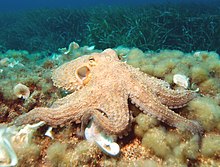Octopodes
| Octopus Temporal range: 323.2 – 0 Ma Late Carboniferous – recent |
|
|---|---|
 |
|
|
Common octopus (Octopus vulgaris) |
|
| Scientific classification | |
| Kingdom: | Animalia |
| Phylum: | Mollusca |
| Class: | Cephalopoda |
| Subclass: | Coleoidea |
| (unranked): | Neocoleoidea |
| Superorder: | Octopodiformes |
| Order: |
Octopoda Leach, 1818 |
| Suborders | |
| Synonyms | |
|
|
The octopus (/ˈɒktəpəs/ or ~/pʊs/ ) is a soft-bodied, eight-armed mollusc of the order Octopoda. Around 300 species are recognised and the order is grouped within the class Cephalopoda with squids, cuttlefish and nautiloids. Like other cephalopods, the octopus is bilaterally symmetric with two eyes and a beak, with its mouth at the centre point of the arms (which are sometimes mistakenly called "tentacles"). The soft body can rapidly alter its shape, enabling octopuses to squeeze through small gaps. They trail their eight arms behind them as they swim. The siphon is used both for respiration and for locomotion, by expelling a jet of water. Octopuses have a complex nervous system and excellent sight, and are among the most intelligent and behaviourally diverse of all invertebrates.
Octopuses inhabit various regions of the ocean, including coral reefs, pelagic waters, and the seabed; some live in the intertidal zone and others at abyssal depths. Most species grow fast, mature early and are short-lived. During breeding, the male uses a specially adapted arm to deliver a bundle of sperm directly into the female's mantle cavity, after which he becomes senescent and dies. The female deposits fertilised eggs in a den and cares for them until they hatch, after which she also dies.
...
Wikipedia
